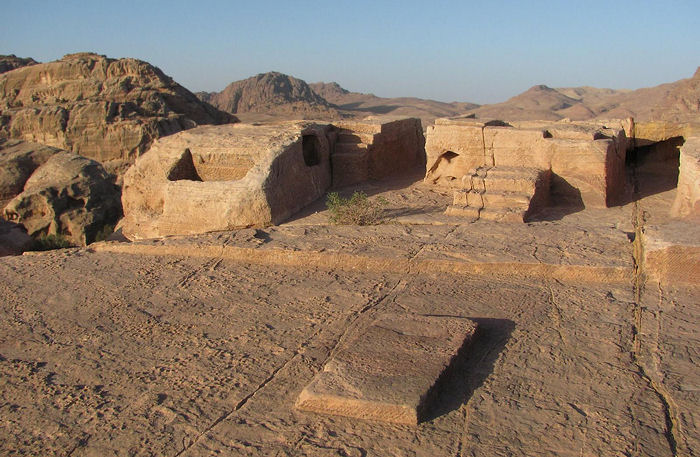The Mountain of God

The Edomite temple at the summit of Jebel Madhbah. This may have been the very place where the Bible says Moses communed with God and received the Ten Commandments.
Like the Obelisk Terrace, the temple at the summit of the mountain is cut from the solid bedrock, and is thought to date from the same period. On the flat mountain top, a large rectangular depression, measuring approximately forty-five by twenty feet, had been neatly cut from the sandstone to a depth of some fifteen inches, and all around it are the remains of rock-cut benches where worshipers would once have sat. Near the middle of this courtyard, as archaeologists refer to it, there is a raised stone platform, six foot by three, which was probably used for offerings, and at the west end there is a solid stone altar, three and a half feet high and six feet wide, standing next to a huge stone basin about the same size. The main altar had steps carved up to it and was probably where the Edomite priesthood presided over rites, while the basin is thought to have been used to contain the blood of sacrificial animals. If Graham was right, then this was the very spot where the Bible says Moses communed with God, and where the stone tablets inscribed with the Ten Commandments were cut. It was, in fact, the place where the religious laws of the ancient Israelites were conceived, and where Western monotheism first began.

The High Place on Jebel Madhbah, showing the Obelisk Terrace, where the Israelites may have gathered, and the summit temple, where Moses may have communed alone with God. (Photograph: Jane Taylor.)
Everything certainly fits with Jebel Madhbah being the biblical Mountain of God. The Old Testament passages suggests that the mountain was in the land of Edom, specifically on the border of the kingdom of Edom where Moses created the miraculous spring. The local Bedouin have long believed that the shrine near the entrance to the Siq, at the foot of Jebel Madhbah, was the site of this spring. The two levels of the mountain match the biblical descriptions of Mount Sinai, and the Exodus account even seem to provide an exact description of Obelisk Terrace as it would have appeared at the time. There is even the strange sound caused by the wind at the foot of the mountain, which would account for the Exodus description of the trumpet exceedingly loud.
The High Place
Conclusion
Page 4 of 4








